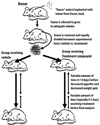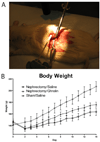Animal models of anorexia and cachexia
- PMID: 20160874
- PMCID: PMC2771941
- DOI: 10.1517/17460440903300842
Animal models of anorexia and cachexia
Abstract
BACKGROUND: Cachexia is a devastating syndrome of body wasting that worsens quality of life and survival for patients suffering from diseases such as cancer, chronic kidney disease and chronic heart failure. Successful treatments have been elusive in humans, leaving a clear need for the development of new treatment compounds. Animal models of cachexia are able to recapitulate the clinical findings from human disease and have provided a much-needed means of testing the efficacy of prospective therapies. OBJECTIVE: This review focuses on animal models of cachexia caused by cancer, chronic heart failure and chronic kidney disease, including the features of these models, their implementation, and commonly-followed outcome measures. CONCLUSION: Given a dire clinical need for effective treatments of cachexia, animal models will continue a vital role in assessing the efficacy and safety of potential treatments prior to testing in humans. Also important in the future will be the use of animal models to assess the durability of effect from anti-cachexia treatments and their effect on prognosis of the underlying disease states.
Figures




Similar articles
-
Update on melanocortin interventions for cachexia: progress toward clinical application.Nutrition. 2010 Feb;26(2):146-51. doi: 10.1016/j.nut.2009.07.003. Epub 2009 Dec 8. Nutrition. 2010. PMID: 20004082 Free PMC article. Review.
-
Ghrelin and cachexia: will treatment with GHSR-1a agonists make a difference for patients suffering from chronic wasting syndromes?Mol Cell Endocrinol. 2011 Jun 20;340(1):97-105. doi: 10.1016/j.mce.2011.02.012. Epub 2011 Feb 25. Mol Cell Endocrinol. 2011. PMID: 21354462 Free PMC article. Review.
-
Establishing a clinical phenotype for cachexia in end stage kidney disease - study protocol.BMC Nephrol. 2018 Feb 13;19(1):38. doi: 10.1186/s12882-018-0819-3. BMC Nephrol. 2018. PMID: 29439674 Free PMC article.
-
Anorexia and Cachexia.2025 Jan 19. In: StatPearls [Internet]. Treasure Island (FL): StatPearls Publishing; 2025 Jan–. 2025 Jan 19. In: StatPearls [Internet]. Treasure Island (FL): StatPearls Publishing; 2025 Jan–. PMID: 28613696 Free Books & Documents.
-
The role of ghrelin in anorexia-cachexia syndromes.Vitam Horm. 2013;92:61-106. doi: 10.1016/B978-0-12-410473-0.00003-9. Vitam Horm. 2013. PMID: 23601421 Review.
Cited by
-
A New Transgenic Mouse Model of Heart Failure and Cardiac Cachexia Raised by Sustained Activation of Met Tyrosine Kinase in the Heart.Biomed Res Int. 2016;2016:9549036. doi: 10.1155/2016/9549036. Epub 2016 May 19. Biomed Res Int. 2016. PMID: 27298830 Free PMC article.
-
Failure-to-thrive syndrome associated with tumor formation by Madin-Darby canine kidney cells in newborn nude mice.Comp Med. 2013 Aug;63(4):323-30. Comp Med. 2013. PMID: 24209967 Free PMC article.
-
Systemic organ wasting induced by localized expression of the secreted insulin/IGF antagonist ImpL2.Dev Cell. 2015 Apr 6;33(1):36-46. doi: 10.1016/j.devcel.2015.02.012. Dev Cell. 2015. PMID: 25850671 Free PMC article.
-
Diet composition as a source of variation in experimental animal models of cancer cachexia.J Cachexia Sarcopenia Muscle. 2016 May;7(2):110-25. doi: 10.1002/jcsm.12058. Epub 2015 Oct 15. J Cachexia Sarcopenia Muscle. 2016. PMID: 27493865 Free PMC article. Review.
-
Metastasis and cachexia: alongside in clinics, but not so in animal models.J Cachexia Sarcopenia Muscle. 2019 Dec;10(6):1183-1194. doi: 10.1002/jcsm.12475. Epub 2019 Aug 22. J Cachexia Sarcopenia Muscle. 2019. PMID: 31436396 Free PMC article. Review.
References
-
- Tisdale MJ. Biology of cachexia. J. Natl. Cancer Inst. 1997;89:1763–1773. - PubMed
-
- DeBoer MD, Marks DL. Therapy insight: Use of melanocortin antagonists in the treatment of cachexia in chronic disease. Nat Clin Pract Endocrinol Metab. 2006;2:459–466. - PubMed
-
- Laviano A, Meguid MM, Inui A, Muscaritoli M, Rossi-Fanelli F. Therapy insight: Cancer anorexia-cachexia syndrome--when all you can eat is yourself. Nat Clin Pract Oncol. 2005;2:158–165. - PubMed
-
- Huang QH, Hruby VJ, Tatro JB. Role of central melanocortins in endotoxin-induced anorexia. Am. J. Physiol. 1999;276:R864–R871. - PubMed
-
- Marks DL, Butler AA, Turner R, Brookhart GB, Cone RD. Differential role of melanocortin receptor subtypes in cachexia. Endocrinology. 2003;144:1513–1523. - PubMed
Grants and funding
LinkOut - more resources
Full Text Sources
Other Literature Sources
